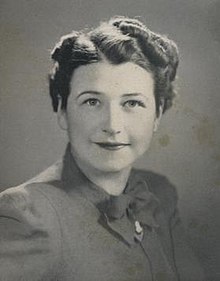Ruth Graves Wakefield: Difference between revisions
m Reverted edits by 207.183.239.190 (talk) (HG) (3.4.10) |
littered with errors and was informal |
||
| Line 40: | Line 40: | ||
==Death== |
==Death== |
||
Ruth retired in 1966 and sold the Toll House which burned down in 1984. Ruth passed away on January 10, 1977 in Plymouth, Massachusetts at the age of 73. |
|||
==References== |
==References== |
||
Revision as of 17:05, 27 February 2023
Ruth Graves Wakefield | |
|---|---|
 | |
| Born | Ruth Jones Graves Wakefield June 17, 1903 |
| Died | January 10, 1977 (aged 73) |
| Education | Framingham State Normal School |
| Spouse |
Kenneth Donald Wakefield
(m. 1926) |
| Children | 2 |
| Culinary career | |
| Cooking style | American |
Previous restaurant(s)
| |
Ruth Jones Graves Wakefield (June 17, 1903 – January 10, 1977; maiden name: Ruth Graves) was an American chef, best known as the inventor of the Toll House Cookie, the first chocolate chip cookie. She was also a dietitian, educator, business owner, and author.[1]
Personal life
Ruth Graves Wakefield was born on June 17th, 1903 and lived until January 10th, 1977[3]. She was born to Helen Vest Jones and Fred Graves and grew up in Easton Massachusetts [2]. To further her education, she attended what is now the Framingham State College where she studied to become a dietician and a food lecturer [2]. She graduated in 1924 and in 1926 married Kenneth Wakefield, a meatpacking executive [3]. Together they had a son Kenneth Donald Wakefield Jr.
Toll House Inn
Ruth and her husband bought a tourist lodge that they called the Tollhouse Inn [1]. They called it this because it was located on what used to be the toll road between Boston and New Bedford [3]. Ruth cooked for the guests using her own recipes and some of her grandmother’s old recipes that were a smash hit and grew the Inn’s dining room from seven tables to sixty [3]. Her recipes were so popular that she released multiple cookbooks, the most popular being a cookbook titled Ruth Wakefield’s Tried and True Recipes in 1931[3]. The book went through 39 printings [5].
Inventing the "Toll House" Chocolate Chip Cookie
There are two stories about how Wakefield invented the cookie [2]. One is a myth in which she ran out of baker’s chocolate for her famous Butter Drop Cookies and instead had to resort to cutting up a Nestle semi-sweet chocolate bar [4]. In reality she decided that she wanted to offer a different option besides the Inn’s current cookie offering which was a butterscotch nut cookie [2].
The pain point that Wakefield identified was the lack of diversity in her Inn’s cookie offerings. Her solution was to experiment with semi-sweet chocolate to create a new cookie flavor. The cookie got so popular that it was featured in newspapers and the Wakefield’s received countless letters from people requesting the recipe and the Toll House Cookie became the most popular dessert of the time [2].
Her use of Nestle chocolate was beneficial for both parties because Nestle’s semi-sweet chocolate bar sales went through the roof, and the two came together in an agreement where nestle began to print the Toll House cookies recipe on their packaging [5]. Part of Ruth’s payment was Nestle’s agreement to give her as much chocolate as she needed for the rest of her life [5]. With this new deal Nestle started packaging their bars with a special breaking tool, then they began to break apart the chocolate bar prior to packaging it, and finally they landed on the chocolate chips that we have today [3].
Toll House Cookies and WWII
The Toll House Cookies rose to popularity in 1940, during WWII which lasted from 1939-1945 [3]. Ruth’s cooking assistant’s daughter recalls days in the kitchen filled with packing care packages to send to the Massachusetts troops overseas [3]. They soon began receiving letters from all over the country requesting that the packages including Toll House Cookies be sent to troops from other states [3].
Death
Ruth retired in 1966 and sold the Toll House which burned down in 1984. Ruth passed away on January 10, 1977 in Plymouth, Massachusetts at the age of 73.
References
- ^ Randal W. Oulton. "Ruth Wakefield". Cooksinfo.com. Retrieved 2016-09-09.
References [1] [2] [3] [4] [5] [6]
External links
- ^ Babwa, A. (2007, January 29). Who is Ruth Wakefield?. https://onesearch.library.northeastern.edu/permalink/01NEU_INST/87npqb/cdi_proquest_newspapers_194853614
- ^ Harkin, S. (2020, December 11). Ruth Graves Wakefield Biography for Kid. https://www.lottie.com/blogs/strong-women/ruth-graves-wakefield-biography-for-kids
- ^ Kelly, K. (n.d.). Chocolate chip cookie inventor: Ruth Wakefield (1903-1977). America Comes Alive. https://americacomesalive.com/chocolate-chip-cookie-inventor-ruth-wakefield/
- ^ Ruth Wakefield. Famous Women Inventors. (n.d.). http://www.women-inventors.com/Ruth-Wakefield.asp
- ^ Ruth Wakefield. Lemelson. (n.d.). https://lemelson.mit.edu/resources/ruth-wakefield
- ^ Global Chocolate Chip Cookies Market. Dataintelo. (n.d.). https://dataintelo.com/report/chocolate-chip-cookies-market/
